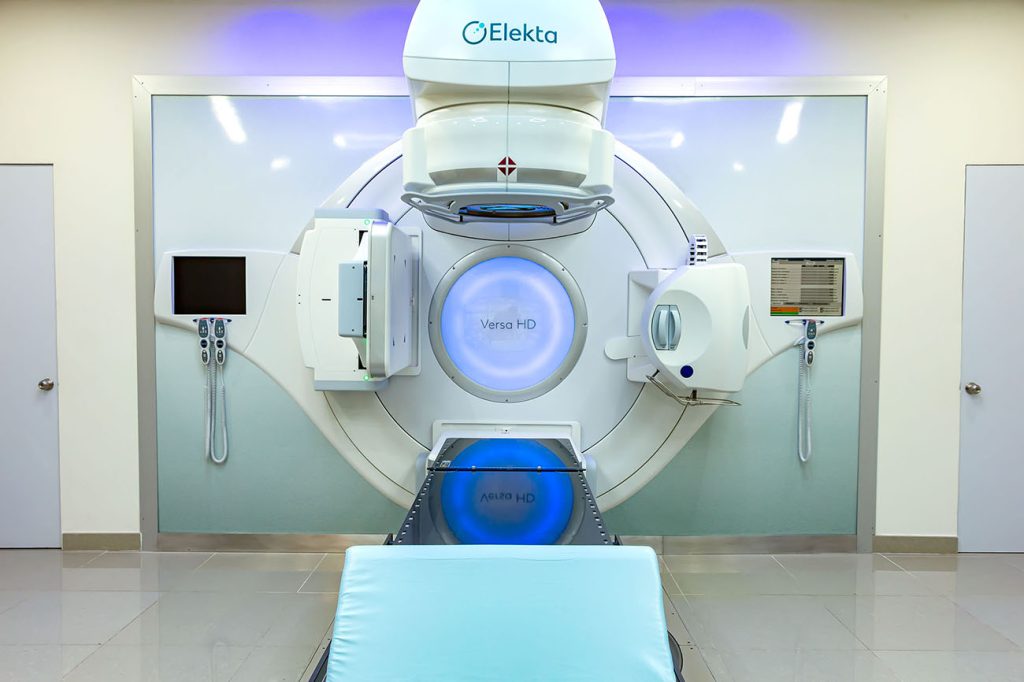Radiotherapy treatment of different types of cancer
Cutting-Edge Radiation Therapy Technology
Featuring the most advanced setup nationwide, our ELEKTA Versa HD radiation therapy machine integrates the market’s most sophisticated components to enhance precision, safety, and effectiveness.
We offer highly specialized treatments, ranging from conventional treatments with standard techniques to the most modern and cutting-edge treatments with advanced techniques.

Conventional Radiotherapy Techniques
What are they and how are they used?
Superficial Electron Radiation Therapy
This technique involves electron-based radiation therapy, which ensures the maximum dose delivery to the patient's skin. It is used primarily for cases of skin cancer, as well as to improve aesthetics in keloid scar healing.
Two-Dimensional (2D) Radiation Therapy
Two-dimensional radiation therapy allows only for simple treatments and is typically used for palliative care. Using this technique, doses are administered with protective measures for treatments employing Photon and Electron energies with single fields.
Three-Dimensional (3D) Radiation Therapy
This technique involves delivering homogeneous doses to the target treatment volume. It utilizes a 3D simulation computed tomography (CT) scan for its calculation, along with safeguards for treatments involving Photons and Electrons. Typically, 1 to 6 fields are used. In contrast to two-dimensional radiation therapy, three-dimensional conformal radiation therapy delivers radiation to cancerous cells with greater precision while minimizing radiation exposure to healthy tissue. This conventional form of radiation therapy is used to treat cancerous and non-cancerous tumors throughout the body.
Advanced Precision Radiation Therapy Techniques
Dynamic Intensity Modulated Radiation Therapy (IMRT):
This technique involves multiple treatment fields to concentrate the dose on the tumor, allowing for intensity modulation in the area being treated. Typically, more than 6 treatment fields are used. IMRT often requires multiple (fractionated) treatment sessions on different days. The radiation oncologist considers the type, location, and size of the tumor, doses to normal structures, and the patient's health to determine the number of treatments. At the start of the treatment session, the radiation therapist positions the patient on the table, guided by marks on the skin (tattoos) that define the treatment area. Molded devices will be used to keep the patient in the proper position. The patient may be repositioned during the procedure. Imaging systems in the treatment machine, such as X-rays or computed tomography (CT), can be used to check positioning and marker location.
Adaptive Four-Dimensional (4D) Radiation Therapy
This technique involves delivering homogeneous doses to the target treatment volume. It uses real-time cone-beam computed tomography (CBCT) images to finely adjust the treatment volume. Rather than capturing images at a single moment, it captures a series of images of the treatment area in the various positions it may take. In 4D Radiation Therapy, these images can accurately replicate the patient's real-time movement. For instance, in breast cancer, thanks to these technical resources, toxicity in adjacent organs can be reduced by at least 5%, significantly mitigating the side effects of cancer treatments. This implies that safety and health are significantly improved, as organs like the heart are far less impacted.
Volumetric Modulated Arc Therapy (V-MAT)
This technique achieves greater precision than IMRT in less time, potentially allowing for higher doses to the tumor and greater protection to healthy organs. VMAT delivers a continuous beam of radiation in one or multiple arcs that move around the treatment area. It automatically changes the shape of the beam and radiation dose as it moves. Treatment sessions with VMAT are typically shorter than IMRT, lasting around 10 minutes.
Cranial Stereotactic Radiosurgery
Outpatient procedures used as an alternative to surgical procedures. Cranial Stereotactic Radiosurgery (SRS) and Cranial Fractionated Stereotactic Radiosurgery (SRT) techniques circumvent the need for brain incisions, thus reducing morbidity and/or long-term effects, while boasting a similar or even higher success rate, at a lower cost and reduced risk compared to traditional surgical procedures performed in an operating room. This procedure is outpatient and non-invasive. There are two types of cranial stereotactic radiosurgeries:
• Cranial Stereotactic Radiosurgery (SRS): This technique delivers a very high dose of radiation in a single fraction. It’s a modern and precise therapeutic technique where small volumes of the skull are irradiated with high doses of radiation. A precise immobilization and fixation technique, specialized software, medical expertise, and the ability to utilize and merge images from Computed Tomography (CT), Magnetic Resonance Imaging (MRI), Positron Emission Tomography (PET), and digital angiography are required. This enables the precise localization of a specific point in the brain. This procedure is outpatient and non-invasive.
• Fractionated Cranial Stereotactic Radiosurgery (SRT): This technique delivers a very high dose of intracranial radiotherapy from one up to five fractions. This tool proves highly beneficial in treating malignant cranial lesions in pediatric patients. By reducing radiation exposure, it effectively prevents significant cognitive function impairment caused by toxicity. It is especially beneficial for head and neck tumors. This procedure is outpatient and non-invasive.
Stereotaxic Ablative Corporal Radiosurgery (SABRT)
This technique delivers a very high dose of extracranial radiation therapy, ranging from one to up to five fractions. The procedure employs multiple precisely focused radiation entry points to treat tumors and other issues throughout the body. Stereotactic body radiation therapy is employed to treat tumors in the lungs, spine, liver, neck, lymph nodes, or other soft tissues, thereby avoiding surgical procedures.
Hipofractionated Treatments
An external radiation therapy technique that, in selected medical cases, could decrease the number of radiation therapy sessions for a patient while maintaining the same effectiveness as traditional treatment. This makes it more convenient for the patient to have fewer appointments while upholding effectiveness and safety standards throughout the process. For instance:
– Prostate Cancer being treated with conventional fractionation in 43 working days could potentially be reduced to 20 working days.
– Breast Cancer being treated with conventional fractionation in 25 working days could potentially be reduced to 15 working days.
Benefits:
- With our versatile machine, we are able to treat practically any type and location of malignant tumors and benign pathologies, offering highly specialized treatments with innovative world-class technology.
- Greater speed, comfort, and security: reliable, fast, and secure technology that helps significantly reduce treatment time compared to other machines.
- Submillimeter precision: The Four-Dimensional Imaging System (4D) enables real-time adaptation to the shape and size by scanning the tumor or tumor bed and even tracking the patient’s breathing during treatment using the Active Breathing Coordinator (ABC) application. Additionally, it features a Robotic Fixation System (HexaPOD™) that allows the treatment table to rotate for precise and safe patient positioning during radiation.
- Our machine provides a vast array of radiation therapy treatment options, including methods such as: Superficial Radiation Therapy, 2D, 3D, 4D, Dynamic IMRT, V-MAT, and both Cranial and Body Radiosurgeries (SRS, SRT, and SABRT).
- Treatment of benign tumors (arteriovenous malformations, pituitary macroadenoma, meningiomas, trigeminal neuralgia, acoustic neurinoma or vestibular schwannoma)
- Treatments to improve the appearance of keloid scars.

